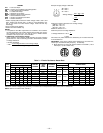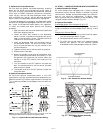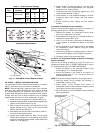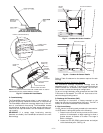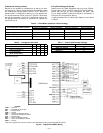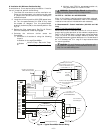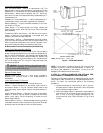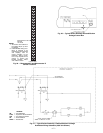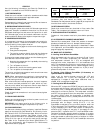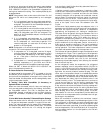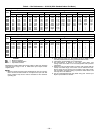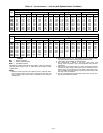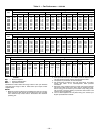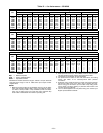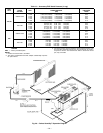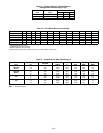
—
18
—
START-UP
Use the following information and Start-Up Checklist on
page CL-1 to check out unit PRIOR to start-up.
I. UNIT PREPARATION
Check that unit has been installed in accordance with these
installation instructions and all applicable codes.
II. COMPRESSOR MOUNTING
Compressors are internally spring mounted. Do not loosen or
remove compressor holddown bolts.
III. REFRIGERANT SERVICE PORTS
Each refrigerant system has a total of 3 Schrader-type service
gage ports. One port is located on the suction line, one on the
compressor discharge line, and one on the liquid line. In addi-
tion Schrader-type valves are located underneath the low-
pressure switches. Be sure that caps on the ports are tight.
IV. COMPRESSOR ROTATION
It is important to be certain the compressors are rotating in
the proper direction. To determine whether or not compres-
sors are rotating in the proper direction:
1. Connect service gages to suction and discharge pres-
sure fittings.
2. Energize the compressor.
3. The suction pressure should drop and the discharge
pressure should rise, as is normal on any start-up.
If the suction pressure does not drop and the discharge pres-
sure does not rise to normal levels:
1. Note that the evaporator fan is probably also rotating
in the wrong direction.
2. Turn off power to the unit.
3. Reverse any two of the incoming power leads.
4. Turn on power to the compressor.
The suction and discharge pressure levels should now move
to their normal start-up levels.
NOTE: When compressors are rotating in the wrong direc-
tion, the unit will have increased noise levels and will not
provide heating and cooling.
After a few minutes of reverse operation, the scroll compres-
sor internal overload protection will open, which will acti-
vate the unit’s lockout and requires a manual reset. Reset is
accomplished by turning the thermostat on and off.
V. INTERNAL WIRING
Check all electrical connections in unit control boxes; tighten
as required.
VI. CRANKCASE HEATERS
Heaters are energized as long as there is power to unit and
compressor is not operating.
IMPORTANT: Unit power must be on for 24 hours prior to
start-up. Otherwise, damage to compressor may result.
VII. EVAPORATOR FAN
Fan belt and variable pulleys are factory installed. Remove
tape from the fan pulley. See Table 8 for Air Quantity Limits.
See Tables 9-12 for Fan Performance data. Be sure that fans
rotate in the proper direction. See Tables 13 and 14 for
Static Pressure information for accessories and options. See
Table 15 for fan rpm at various fan motor pulley settings.
See Table 16 for Evaporator-Fan Motor Specifications. To
alter fan performance, see Evaporator-Fan Performance
Adjustment section, page 26.
Table 8 — Air Quantity Limits
VIII. CONDENSER FANS AND MOTORS
Condenser fans and motors are factory set. Refer to
Condenser-Fan Adjustment section (page 28) as required. Be
sure that fans rotate in the correct direction.
IX. RETURN-AIR FILTERS
Check that correct filters are installed in filter tracks. See
Table 1. Do not operate unit without return-air filters.
X. OUTDOOR-AIR INLET SCREENS
Outdoor-air inlet screens must be in place before operating
unit.
XI. ACCESSORY ECONOMI$ER ADJUSTMENT
Remove filter access panel. Check that outdoor-air damper
blades are closed and return-air damper blades are open.
EconoMi$er operation and adjustment is described in Base
Unit Operation and EconoMi$er Adjustment sections (this
page and page 28), respectively.
XII. BASE UNIT OPERATION
A. Cooling, Units Without EconoMi$er
When thermostat calls for cooling, terminals G and Y1 are
energized. The indoor (evaporator) fan contactor (IFC),
and compressor contactor no. 1 (C1) are energized and
evaporator-fan motor, compressor no. 1 and condenser fans
start. The condenser-fan motors run continuously while unit
is cooling. If the thermostat calls for a second stage of cooling
by energizing Y2, compressor contactor no. 2 (C2) is ener-
gized and compressor no. 2 starts.
B. Heating, Units Without EconoMi$er (If Accessory or
Optional Heater is Installed)
Upon a call for heating through terminal W1, IFC and
heater contactor no. 1 (HC1) are energized. On units
equipped for 2 stages of heat, when additional heat is
needed, HC2 is energized through W2.
C. Cooling Units With EconoMi$er
When the OAT is above the ECON SP set point and the room
thermostat calls for Stage 1 cooling (R to G + Y1), the indoor-
fan motors (IFM) is energized and the EconoMi$er damper
modulates to minimum position. The compressor contactor
and OFC are energized to start the compressor and outdoor-
fan motor (OFM). After the thermostat is satisfied, the
damper modulates to the fully closed position when the IFM
is deenergized.
When the OAT is below the ECON SP setting and the room
thermostat calls for Stage 1 cooling (R to G + Y1), the
EconoMi$er modulates to the minimum position when the
IFM is energized. The EconoMi$er provides Stage 1 of cool-
ing by modulating the return and outdoor air dampers to
maintain a 55 F supply air set point. If the supply-air tem-
perature (SAT) is greater than 57 F, the EconoMi$er modu-
lates open, allowing a greater amount of outdoor air to enter
the unit. If the SAT drops below 53 F, the outdoor air damper
modulates closed to reduce the amount of outdoor air. When
the SAT is between 53 and 57 F, the EconoMi$er maintains
its position.
UNIT
551A
MINIMUM CFM MAXIMUM CFM
155
3600 6,000
180
4500 7,500
240
6000 10,000



